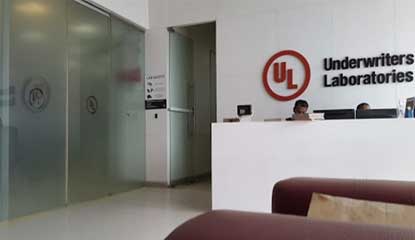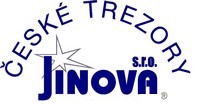
Americké standardy UL jsou používány k posouzení produktů, testování komponent, materiálů, systémů a vylepšení, a k hodnocení udržitelného výrobku z hlediska životního prostředí, obnovitelnosti energií, potravin, vody, recyklačních systémů a a dalších inovativních technologií. Americká laboratoř.

UL je nezávislá bezpečnostně vědecká společnost s více než stoletím zkušeností s inovativními bezpečnostními řešeními. Od veřejného použití elektrické energie až po nové objevy, objevy udržitelných zdrojů energie a nanotechnologie. UL podporuje bezpečné životní a pracovní prostředí, UL pomáhá chránit lidi, produkty a místa v důležitých ohledech,
usnadňování obchodu a poskytuje klid.
UL 687 - Standardy pro trezory odolné zloději
Trezory jsou zkoušeny měřeným náporem odborníků z laboratoří UL. Takové trezory pak pravděpodobně zmaří úsilí i dnešního profesionálního zloděje. I když je trezor odvezen nebo je použito nejmodernější nářadí a sofistikované nástroje. Testy UL jsou vedeny přímo poti zámku se snahou ho srazit a vybrat zámek. Testuje se také ostatní ústrojí trezoru. V první řadě se ale trezory zkouší vrtáním, řezáním a použitím nejmosernější high-tech pochodně nebo určitým množstvím Nitroglycerinu.
Test napadení proti dveřím a čelní straně:
- 1) Tool-Resistant Safe - Class TL-15
- 2) Tool-Resistant Safe - Deposit Safe
- 3) Tool-Resistant Safe - Class TL-30
- 4) Torch- and Tool-Resistant Safe - Class TRTL-30
Test napadení proti dveřím a plášti:
- 1) Tool-Resistant Safe - Class TL-15X6
- 2) Tool-Resistant Safe - Class TL-30X6
- 3) Torch- and Tool-Resistant Safe - Class TRTL-15X6
- 4) Torch- and Tool-Resistant Safe - Class TRTL-30X6
- 5) Torch- and Tool-Resistant Safe - Class TRTL-60X6
- 6) Torch-, Explosive-, and Tool-Resistant Safe - Class TXTL-60X6
UL 437 - Standard for Key Locks
These requirements cover key locks categorized as follows and defined in Glossary, Section 3:
- a) Cabinet locking cylinders,
- b) Door locks,
- c) Locking cylinders,
- d) Security container key locks, Type 1 and Type 2, and
- e) Two-key locks.
A product that contains features, characteristics, components, materials, or systems new or different from those covered by the requirements in this standard, and that involves a risk of fire or of electric shock or injury to persons shall be evaluated using appropriate additional component and end-product requirements to maintain the level of safety as originally anticipated by the intent of this standard. A product whose features, characteristics, components, materials, or systems conflict with specific requirements or provisions of this standard does not comply with this standard. Revision of requirements shall be proposed and adopted in conformance with the methods employed for development, revision, and implementation of this standard.
UL 155 - Standard for Tests for Fire Resistance of Vault and File Room Doors
1.1 These requirements cover the test procedure applicable to the fire-resistance classification of doors intended for the protection of openings of vaults and file rooms.
1.2 Recommendations for record protection equipment and techniques, including the use and installation of vault or file room door assemblies, are contained in the Standard for Protection of Records, NFPA 232.
1.3 The terms "vault doors" and "file room doors" refer to assemblies consisting of doors, single or in pairs, the frame into which doors are hung, and the necessary hardware. These assemblies are intended to provide fire resistance and protection to contents from heat for periods designated by the classifications to an extent described in these requirements.
1.4 Vault doors are recommended for use on enclosures of limited volume [not exceeding 5000 cubic feet (142 m3)], constructed so that no point on the interior surface will reach a temperature exceeding 350°F (177°C) when separate vault members or the vault as a whole are exposed to a fire regulated according to the standard time-temperature curve.
1.5 File room doors are recommended for enclosures of large volume [not exceeding 50,000 cubic feet (1420 m3)] for the storage of records which are not of sufficient importance to economically justify the provision of vaults. It is anticipated that combustibles will not be stored nearer than 3 feet (0.91 m) from the unexposed face of the door nor 6 inches (152 mm) to the side from the door joints.
Ul underwriters laboratories
1.6 It is intended that classification shall register performance during the period of exposure and shall not be construed as having determined suitability for use after fire exposure.
1.7 A product that contains features, characteristics, components, materials, or systems new or different from those covered by the requirements in this standard, and that involves a risk of fire or of electric shock or injury to persons shall be evaluated using appropriate additional component and end-product requirements to maintain the level of safety as originally anticipated by the intent of this standard. A product whose features, characteristics, components, materials, or systems conflict with specific requirements or provisions of this standard does not comply with this standard. Revision of requirements shall be proposed and adopted in conformance with the methods employed for development, revision, and implementation of this standard.
UL 350 - 1 Hour Fire Rating
Trezory procházejí přísnou zkoušku ohněm , když se zahřeje na teplotu 2000 stupňů F a klesl tři příběhy na rozbitých cementových bloků . Trezory nelze otevřít , může teplota uvnitř nezvedne nad 350 stupňů F a vzorových dokumentů zůstat uvnitř musí být čitelné .
UL 608 - Standard for Burglary Resistant Vault Doors and Modular Panels
1.1 These requirements cover vault doors and vault modular panels (for use in the construction of vault floors, walls, and ceilings) of the type intended for use in financial institutions, commercial, industrial and mercantile properties, and the like, and that are relied upon to protect the contents from burglary attack.
1.2 These requirements are intended to establish the burglary resistant rating of vault doors and modular panels according to the length of time they withstand attack by common mechanical tools, electric tools, cutting torches, or any combination of these means. The ratings based on the net working time to effect entry are as follows:
- a) Class M - 1/4 hour.
- b) Class 1 - 1/2 hour.
- c) Class 2 - 1 hour.
- d) Class 3 - 2 hours.
1.3 These requirements do not cover attacks with the burning bar (thermal lance) or explosives.
UL 140 Standard for Relocking Devices for Safes and Vaults
1.1 These requirements cover relocking devices for the following: a) Light vault doors, b) Heavy vault doors, and c) Safes or chests. 1.2 Relocking devices are intended to relock the bolt mechanism or door of a vault, safe, or chest in the event that the combination lock is subjected to attack. 1.3 A product that contains features, characteristics, components, materials, or systems new or different from those covered by the requirements in this standard, and that involve a risk of fire, electric shock, or injury to persons shall be evaluated using the appropriate additional component and end-product requirements as determined necessary to maintain the acceptable level of safety as originally anticipated by the intent of this standard. A product whose features, characteristics, components, materials, or systems conflict with specific requirements or provisions of this standard cannot be judged to comply with this standard. Where considered appropriate, revision of requirements shall be proposed and adopted in conformance with the methods employed for development, revision, and implementation of this standard.
UL 768 - Standard for Combination Locks
1.1 These requirements cover combination locks intended for attachment on doors of safes, chests, vaults, and the like, to provide a means of locking the boltwork against unauthorized opening.
1.2 These requirements are intended to test the ability of combination locks to resist unauthorized opening of the combination locks by sense of sight, touch, or hearing. Combination locks covered by these requirements may or may not have integral protection against entry by force.
